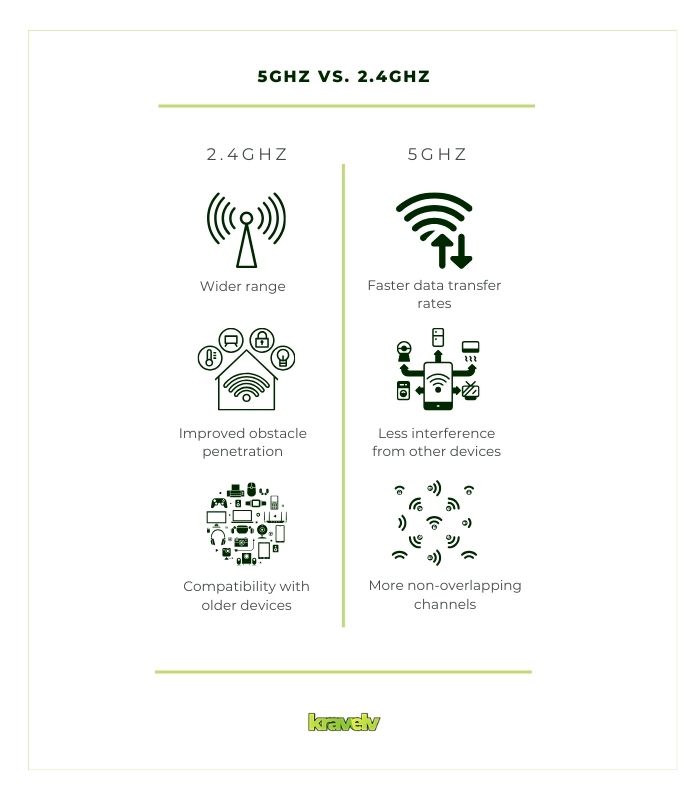Last Updated on April 6, 2025 by Kravelv Spiegel
Wireless communication is now a crucial aspect of our everyday routines, fueling our smartphones, laptops, smart home devices, and various other gadgets. There is a complex network of frequencies that enables seamless connectivity, with two of the most common bands being the 5GHz and 2.4GHz. It is important to grasp the distinctions between 5GHz vs. 2.4GHz bands in order to maximize network performance and guarantee dependable connectivity in different settings.
Key takeaways:
- 5GHz and 2.4GHz Wi-Fi bands differ significantly in terms of speed, range, and interference levels.
- 2.4GHz offers wider coverage and better obstacle penetration, making it ideal for older devices and larger spaces.
- 5GHz delivers faster speeds and lower interference, perfect for bandwidth-heavy tasks and crowded environments.
- Choosing the right band depends on your specific needs—like gaming, streaming, or device compatibility.
Difference between 5GHz and 2.4GHz
2.4GHz
Wi-Fi communication often utilizes the 2.4GHz frequency band, which is a widely used spectrum. The coverage area is wider and it can penetrate obstacles like walls and furniture, making it ideal for use in homes and offices. Other devices operating on the same frequency can interfere with it, degrading Wi-Fi performance, particularly in densely populated areas. Although it has limitations, the 2.4GHz band continues to be relevant because it is compatible with older devices and has been widely adopted.
5GHz
The 5GHz frequency band offers faster data transfer rates and experiences less interference when compared to the 2.4GHz band. Its larger number of non-overlapping channels allows for better performance in high-density environments with multiple Wi-Fi networks. On the other hand, larger homes or buildings may experience limitations in the effectiveness of the 5GHz band due to its shorter range and weaker penetration through walls and obstacles. Bandwidth-intensive tasks like HD video streaming, online gaming, and large file downloads are best suited for the 5GHz band.
5GHz vs 2.4GHz Pros and Cons

2.4GHz Pros and Cons
✅Wider range: The wider coverage area of the 2.4GHz band makes it ideal for larger spaces and environments with multiple rooms or floors. Penetrating through walls and obstacles is more effective with lower frequency bands.
✅Improved obstacle penetration: Walls, furniture, and other obstacles are easily penetrated by the 2.4GHz band, thanks to its lower frequency compared to higher frequency bands. It is well-suited for homes and offices with thick walls or multiple obstructions.
✅Compatibility with older devices: Older devices, like smartphones, laptops, and IoT devices, can only connect to the 2.4GHz band. Ensuring compatibility with legacy devices and equipment is why the 2.4GHz band remains relevant.
❌Interference from other devices can be a concern: The 2.4GHz band is commonly used by household devices like microwaves, cordless phones, and Bluetooth devices. Interference and degraded Wi-Fi performance can be a common issue, particularly in crowded environments.
❌Limited number of non-overlapping channels: There are only three non-overlapping channels available in the 2.4GHz band (channels 1, 6, and 11 in the United States). Multiple Wi-Fi networks operating on the same channel can cause congestion and interference, which can result in a decrease in overall network performance and reliability.
5GHz Pros and Cons
✅Faster data transfer rates: With faster data transfer rates, the 5GHz band is perfect for bandwidth-intensive tasks like HD video streaming, online gaming, and large file downloads. It outperforms the 2.4GHz band in terms of speed.
✅Less interference from other devices: The 5GHz band encounters minimal interference from household appliances, Bluetooth devices, and other wireless networks that operate on the 2.4GHz band. It’s worth noting that a more reliable and stable connection is achieved, particularly in densely populated areas.
✅More non-overlapping channels: In my experience, the 5GHz band provides a greater number of non-overlapping channels when compared to the 2.4GHz band. By optimizing the use of the bandwidth, we can minimize interference and congestion in areas with many Wi-Fi networks.
❌Shorter range: Compared to the 2.4GHz band, the range of the 5GHz band is shorter. I find that walls, furniture, and other obstacles can easily weaken the signal, reducing its coverage area. This can be particularly noticeable in larger homes or buildings.
❌Weaker penetration through walls and obstacles: In my experience, the 5GHz band tends to have poorer penetration capabilities compared to the 2.4GHz band, likely due to its higher frequency. Signal strength and coverage area indoors can be reduced due to obstacles like walls, furniture, and other barriers that attenuate the signal.
5GHz vs 2.4GHz Best for and Recommendations
The 2.4GHz and 5GHz bands have their own strengths and weaknesses, making them suitable for different use cases:
| 2.4GHz | 5GHz |
|---|---|
| Ideal for Long Range: The 2.4GHz band is perfect for covering expansive areas, making it a great choice for environments that require long-range coverage. This includes outdoor areas, warehouses, or rural areas with fewer Wi-Fi networks. Older Device Compatibility: The 2.4GHz band is still the preferred choice for connecting older devices that may not support the 5GHz band, thanks to its widespread adoption and compatibility with legacy devices. | High-Speed Data Transfer: The 5GHz band is ideal for applications that demand fast data transfer, like streaming 4K video, online gaming, or transferring large files. Congestion-Prone Environments: In crowded areas or places with many Wi-Fi networks, the 5GHz band is highly effective. It stands out because it has more non-overlapping channels, which means less interference and congestion. |
Users can optimize their Wi-Fi performance by understanding the strengths of each frequency band and determining the best use cases for their specific networking needs.
2.4GHz vs 5GHz for Gaming: Which Should You Use?
When it comes to online gaming, a stable and fast internet connection can mean the difference between victory and defeat. Choosing the right frequency band—2.4GHz or 5GHz—can directly impact your gaming experience, especially when it comes to latency (ping), speed, and connection stability.
Here’s the key takeaway:
- If you’re close to the router and want the fastest speeds with the lowest lag, go with 5GHz.
- If you’re farther away or have walls and obstacles between your device and the router, 2.4GHz may offer better stability—even if the speed is slower.
5GHz vs 2.4GHz FAQs
Which frequency band should I choose for my home Wi-Fi network?
Choosing between 5GHz vs 2.4GHz will ultimately depend on your individual requirements and the conditions of your surroundings. If speed is your top priority and you have devices that can handle it, like newer smartphones and laptops, you might find the 5GHz band more suitable. On the other hand, if you need a longer range or if your devices are older and only support 2.4GHz, then opting for the 2.4GHz band would be a more suitable option.
How can I determine if my devices are compatible with the 5GHz band?
I’ve noticed that a lot of the latest gadgets, like smartphones, tablets, and laptops, are designed to work with both the 5GHz and 2.4GHz bands. On the other hand, some older devices or specific IoT devices might only be compatible with the 2.4GHz band. If you want to check compatibility, you can refer to your device’s specifications or settings menu. Typically, this is where you can find information about the supported Wi-Fi frequencies.
Will switching to the 5GHz band improve my Wi-Fi performance?
Using the 5GHz band can enhance Wi-Fi performance in specific situations, especially in crowded areas with frequent congestion and interference. On the other hand, it’s crucial to take into account factors like range and device compatibility.
Final words
Ultimately, deciding between 5GHz vs 2.4GHz bands hinges on several factors such as range, speed, interference, and device compatibility. Understanding the strengths and weaknesses of each frequency band allows individuals to make informed decisions to enhance the reliability and performance of their wireless networks in any setting. Keeping up with the latest trends and developments in technology is crucial for making the most of wireless communication’s potential.
Do you have any thoughts on this article? Do you think that there are some points/factors that are missing? Let me know about it in the comments below.

